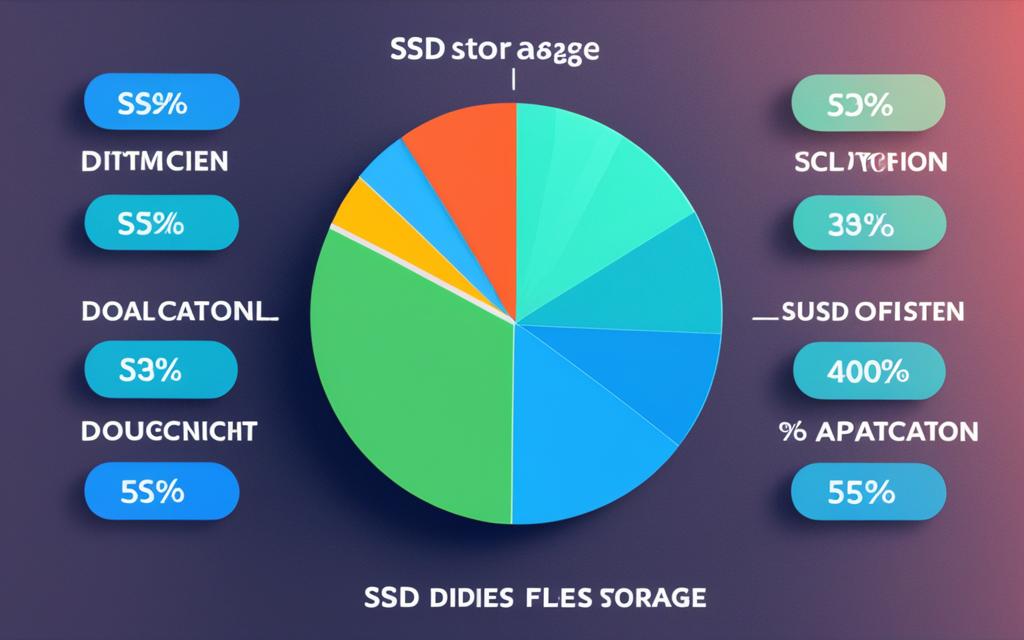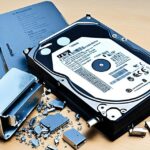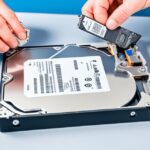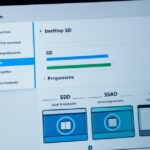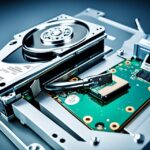Table of Contents
Many users often ask, “What is taking up space on my SSD?” As managing SSD storage gets more important, finding and deleting big, unneeded files is key. Large applications, too much cache, and big system logs often use up a lot of space. It’s crucial to spot these storage problems to keep your computer running well.
Tools like EaseUS Partition Master help point out these issues. This lets users act to make more space available. Acting early not only makes your computer faster but also helps your SSD last longer.
Key Takeaways
- Understanding what consumes space on your SSD is vital for optimal performance.
- Utilising tools like EaseUS Partition Master can facilitate effective SSD storage management.
- Regularly clearing temporary and junk files helps reclaim SSD space.
- Identifying and uninstalling unused applications can improve system efficiency.
- Maintaining a disciplined approach to SSD management can avoid storage issues.
Understanding SSD Storage Limitations
Solid State Drives (SSDs) are a big leap forward in how we store data, giving us speed and reliability better than old Hard Disk Drives (HDDs). With NAND flash memory chips, they let our computers start up and load programs much faster1. But, they come with storage limitations that can be tricky for users. SSDs usually have between 120 GB to 30 TB of space. Most often, they offer 250 GB to 500 GB2.
Comparing SSDs with HDDs
When looking at SSDs versus HDDs, it’s clear SSDs perform much better. They don’t have moving parts, which makes them more durable and reliable2. However, even though they’re quicker, SSDs don’t always offer as much space. These drives fill up faster than HDDs. Also, SSDs vary in performance and space and may be pricer. Plus, they might not last as long due to the way they write data1.
Common SSD Sizes and Their Storage Capacities
SSD storage offers many size options like 250 GB or 500 GB, meeting different needs2. Even though there are SSDs with up to 100 TB, they’re rare and expensive. It’s important for users to think about how much space they need. A lot of it can be taken up by software, files, and backups3. Knowing this helps users plan better for storage, whether they’re upgrading or maintaining their devices.
Methods for Discovering Storage Usage
Learning how to check your SSD space is useful. It involves using Windows settings for a quick look or third-party tools for more detail.
Utilising Windows Settings for Basic Analysis
Checking your SSD space with Windows settings is easy. Just go to the storage settings to see what’s using your disk the most. Windows has a tool called the Performance Monitor. It lets you see how much space you have left, either in megabytes or as a percentage of the total space. You can pick what it tracks, making it easy to see exactly what you want. You can then see this info in graphs through Excel or inside the Performance Monitor. No need for extra software downloads4.
Employing Third-Party Tools for Detailed Insights
If you want deeper details, there are tools made just for this. They include names like MiniTool Partition Wizard and WinDirStat. Each provides unique features for a deep dive into your SSD space. Some tools, like CCleaner or SpaceSniffer, help you find big files or apps you don’t need. Using these tools helps clear up space on your SSD quickly56.
Identifying What is Taking Up So Much Space on My SSD
To make the most of your SSD, it’s essential to know what’s filling it up. Large files and programs often use a lot of space. By looking closely at these, you can decide what to keep and what to delete.
Examining Large Files and Program Installations
Start by finding large files eating up your SSD space. Apps, system files, and temp files are usually the culprits7. Managing apps can help free up space. If you sort apps by size, it’s easier to remove the biggest ones7. Check your programs often to find ones you rarely use. This helps use your storage wisely.
Hidden Files and System Files Impacting Storage
Hidden files can also affect your storage without you noticing. Operating system files, like reserved storage and virtual memory, take up space7. Big files, like hibernation and system restore, also use a lot of space8. You can handle these by deleting unnecessary hibernation files and keeping restore points to a minimum. It’s also good to clean out temp files regularly. These can build up in several folders, such as Downloads and Temporary Internet Files7.
Best Practices for Managing SSD Space
To keep your SSD running well, it’s important to manage its space carefully. Regular maintenance is key. This includes removing temporary files often and knowing how to clean your disk properly.
Regularly Clearing Temporary and Junk Files
Temporary and junk files build up quick, especially if your SSD is small. Removing these files often is crucial. It helps keep your SSD from getting too full and keeps your system running fast.
Using Disk Cleanup Tools Effectively
Using the Disk Cleanup tool helps a lot with SSD space. It gets rid of old files and keeps the SSD at least 25% free. Also, turning off hibernation and clearing the recycle bin can save even more space.
| Practice | Description | Frequency |
|---|---|---|
| Temporary File Removal | Removing unnecessary temporary files created during system operations. | Weekly |
| Disk Cleanup | Utilising built-in tools to delete junk files and optimise storage. | Monthly |
| Using Space Analyzers | Employing software to analyse storage usage and identify large files. | As needed |
| Disabling Hibernation | Turning off hibernation to save space occupied by hibernation files. | One-time |
| Uninstalling Unused Applications | Removing applications that are no longer in use. | As needed |
Strategies to Free Up SSD Space
Keeping your SSD in top shape needs active effort. Using smart methods to clear up space can really boost your computer’s speed. You should think about moving files to other places for storage. Also, getting rid of apps you don’t use is key.
Transferring Files to Alternative Storage Solutions
Protecting your important files while making space on your SSD is easier with external drives or cloud services. They are great for storing big files, like videos and pictures, off your SSD. This prevents your SSD from getting too full. With SSD sizes ranging from 120GB to 1TB, using space wisely is vital11.
Big hibernation files take up a lot of space. Turning off hibernation can save you loads of space on your SSD12.
Uninstalling Unused Applications to Reclaim Space
Getting rid of apps you’re not using anymore is another good move. This can free up a lot of space, helping your system run better. Every so often, check what apps you have and uninstall the ones you don’t need9. Windows has tools that make finding these apps easy. This helps keep your storage in check.
Using disk cleanup tools is another way to help. Regularly clearing out useless files can free up a lot of space on your SSD. This will make your computer perform better11.
Conclusion
Effectively managing SSD storage is key to improving its performance and your computing experience. This article covered many SSD space solutions. We talked about the need to find and delete large files and unused apps that fill up your SSD.
Using tools to check your storage and removing junk files can really help boost your SSD’s space. Keeping your digital space tidy also lowers the chance of your system crashing due to low disk space. Regularly checking for hidden files and removing programs you don’t use can make your SSD work better and last longer.
Understanding how hibernation and overprovisioning affect your SSD can also improve how you use it. By following the tips we discussed, you can keep your SSD storage efficient and effective. Start using these strategies now to see a big difference in your device’s speed and response.
For more on tech basics, like what a kernel is and why it’s important, check out this detailed article on computer kernels. It’s a great resource to help you understand your computer’s core functions1314.
FAQ
What is taking up space on my SSD?
Users find that large files, cache jams, and system logs use a lot of SSD space. It’s key to spot these to manage your SSD well and get space back.
How do SSDs differ from HDDs?
SSDs are faster, more reliable, and tougher than HDDs. While SSDs usually have less space, from 120 GB to 512 GB, bigger sizes up to 100 TB exist but cost more.
What tools can I use to analyse my SSD storage usage?
Start with Windows Settings for a basic look at your SSD. For deeper analysis, EaseUS Partition Master’s Space Analyzer helps see your storage details clearly.
How can I find large files affecting my SSD space?
Check both big files and apps as they take much space. Hidden and system files also fill your SSD. Tools are there to show hidden files, letting you choose what to delete.
What are best practices for maintaining SSD performance?
Keep your SSD in top shape by clearing out temp and junk files. Disk Cleanup tool is handy for removing stuff you don’t need, like old restore points and temp data. Regular cleaning keeps your SSD fast.
What strategies can help me free up space on my SSD?
Move files to external drives or cloud storage. Uninstalling apps you don’t use also frees up SSD space. This approach keeps your digital space tidy.
Source Links
- https://www.techtarget.com/searchstorage/definition/SSD-solid-state-drive – What is an SSD (Solid-State Drive)?
- https://www.avast.com/c-what-is-ssd – What Is a Solid-State Drive (SSD)?
- https://www.partitionwizard.com/clone-disk/ssd-is-full.html – What to Do If Your SSD Is Full [7 Solutions] – MiniTool Partition Wizard
- https://superuser.com/questions/749770/windows-how-can-i-see-disk-space-used-over-time – Windows: How can I see disk space used over time?
- https://www.partitionwizard.com/clone-disk/disk-space-analyzer.html – What Is Taking up Space on PC? Top 7 Disk Space Analyzers Help! – MiniTool Partition Wizard
- https://www.hp.com/us-en/shop/tech-takes/7-hacks-free-up-space-hard-drive – 7 Hacks to Free Up Space on Your Hard Drive | HP® Tech Takes
- https://www.makeuseof.com/whats-taking-up-space-windows/ – How to See What Is Taking Up Too Much Disk Space on Your Windows PC
- https://discussions.apple.com/thread/255257654 – Sonoma Upgrade – HUGE loss of space on SSD
- https://www.easeus.com/computer-instruction/free-up-space-ssd.html – How to Free Up Space on SSD in Windows 10/8/7
- https://www.pcworld.com/article/444461/the-ultimate-guide-to-proper-ssd-management.html – The ultimate guide to proper SSD management
- https://www.isumsoft.com/windows-10/how-to-free-up-space-on-ssd.html – [6 Tips] How Do I Free Up Space on My SSD in Windows 10
- https://www.isunshare.com/computer/how-to-free-up-space-on-ssd-in-windows.html – How to Free Up Space on SSD in Windows [Easy Ways]
- https://www.easeus.com/partition-manager-software/how-to-fix-ssd-full-for-no-reason.html – How to Fix SSD Full for No Reason
- https://forums.linuxmint.com/viewtopic.php?t=352989 – [SOLVED] Partitioning an SSD – should I leave unallocated space?

